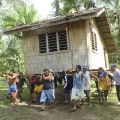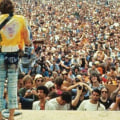Examples of pop culture can be found in language, art, cinema and, in particular, music. This can include 40 pop music, young adult fiction such as Harry Potter, and fleeting pop culture trends, such as flash mobs and clothing styles. The opposite is the alternative culture or subculture, which is a culture practiced by groups of people but that has not reached the masses. Occasionally, elements of the subculture break through and briefly become popular culture, such as the rise of pop punk bands in the late 1990s and early 2000s.
Boy bands have achieved popularity in waves. An earlier wave of boy bands in the 1960s and 70s saw bands like The Monkeys and The Beach Boys rise in popularity. A central feature of boy bands is that they are given a fun pop image designed to attract a wide audience. They often have choreographed dance movements and are mainly vocalists.
They are usually young teens or boys in their 20s who sing love songs to girls. Rock music rose to prominence in the 1960s and 1970s and has enjoyed significant popular success intermittently ever since. Similar British rock bands such as The Rolling Stones, The Kinks and The Who also achieved worldwide fame in the mid-1960s, and before long this group of artists received the nickname “bands of the British invasion” in the United States. Every few years, a children's collector's item bursts into the popular spirit of the time.
A popular example throughout history are the Pogs, which began as collectible milk tapas in the 1920s. In the 1990s, they were distributed in McDonald's happy meals. Dance styles gain popularity in various cultures at different times. In the United States, in the 1950s, the swing dance style was very popular.
In the 1990s, with the popularity of grunge music, mosh-pits became popular. This was followed by the rise of rave culture and electronic dance music, which also involved a somewhat unstructured leap to music. Flash mobs became a very popular part of Western culture in 2003 and remained prominent for about 3 years. The spread of punk peaked with the appearance of megabands of pop punk in the 1990s.
The epitome of this was the band Green Day. Many older punks used the phrase “pop punk” as a term to mock punk music, which had “sold” to corporate interests in order to enjoy popular fame. The heyday of sitcoms was in the 1990s. During this era, comedies (“sitcoms”) appeared on television every night and united a nation.
The music of the top 40 is one of the most prominent ways in which pop culture can be identified. Each year's top 40 charts are commemorated online to help people reflect on what music captured the spirit of the year. Often, music that is in the top 40 is called “charts” to show that this music is the music of the masses. A very popular video game series from the 1980s and 1990s was the Mario series.
To this day, people dress up as characters from video games such as Mario, Toad and Princess for cosplay events. Some say that popular culture tends to support a limited understanding and experience of life through common and unsophisticated feelings and attitudes and its emphasis on the banal, the superficial, the whimsical and the disposable. Pop culture is full of moments of pure joy, but some truly unfortunate events can also dominate headlines, legal battles, deaths and scandals. A postmodernist approach to popular culture would no longer recognize the distinction between high culture and popular culture.
This former layer of culture still persists today, sometimes in the form of jokes or jargon, which are spread among the population by word of mouth and through the Internet. For example, giant pandas (a species from remote Chinese forests) have become well-known objects of popular culture; parasitic worms, although of greater practical importance, have not done so. Both academic facts and news are modified through popular broadcasting, often to the point of becoming blatant falsehoods. In the United States, popcorn and soft drinks in movies are an important cultural trope enjoyed by the masses.
Some Marxists complain that popular culture and its implicit insistence on a necessary causal relationship between consumption and self-realization perpetuate deep and pernicious social and economic divisions that alienate the working class from the dominant, professional and leisure classes and cause general discontent and a decrease in the quality and enjoyment of life for all (compare with Situationism). It considers popular culture as a place of struggle between the “resistance” of society's subordinate groups and the forces of “incorporation” that act for the benefit of society's dominant groups. Cosplay is a form of dressing up (it's an acronym for “dress up game”) in which people dress up like various characters from popular culture. It creates currents and whirls, in the sense that a small group of people will have a strong interest in an area of which mainstream popular culture has only partial knowledge; thus, for example, the electro-pop group Kraftwerk has had an impact on mainstream popular culture to the extent that they have been referred to in The Simpsons and Father Ted.
Many young adult fiction books make their way into the popular imagination and become a big part of popular culture. Pop culture is criticized for focusing too much on money (and culture is driven by capitalism and consumerism), promoted by elites so that the masses consume it without thinking, and for promoting gender, race and social class norms that maintain the subjugation of the disempowered. South America also has its own very popular television programs called telenovelas, which are popular for their dramatic and exaggerated plots. .
.


